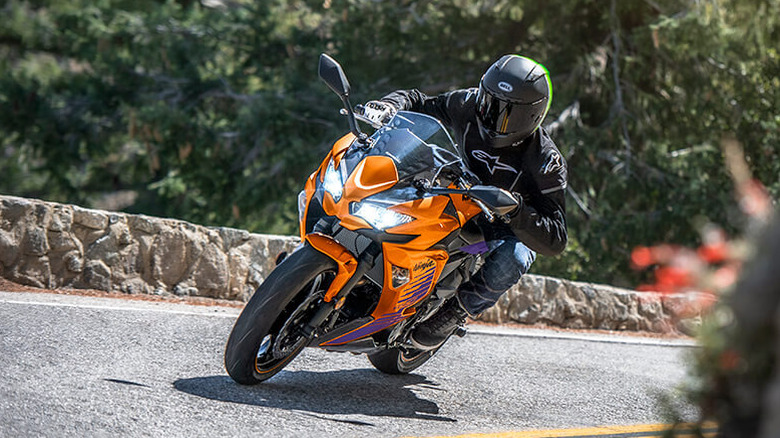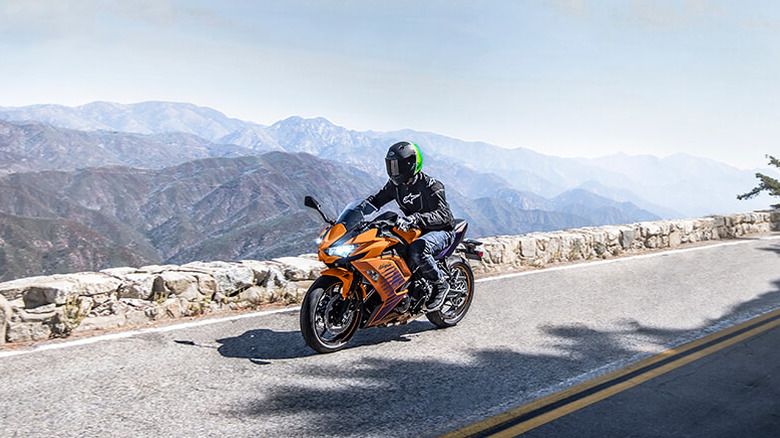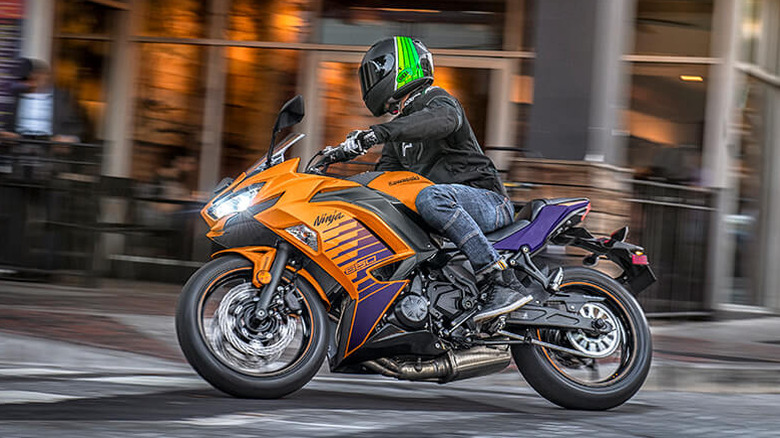How Fast Is The Kawasaki Ninja 650? A Look At Its Top Speed And Acceleration Times
When it comes to sport bikes, Kawasaki has a wide array of available options. It currently has 13 bikes under the Ninja nameplate, all with varying engine sizes, configurations, and capabilities. The top dogs include Kawasaki's biggest and most powerful bikes, like the H2, ZX-14R, and ZX-10R. Moving down into the middle of their sportbike range, bikes like the ZX-6R and ZX-4R offer more modest performance but are still seriously fast. The category Kawasaki simply calls "sport" however, includes bikes like the Ninja 650 — a middleweight sport bike with a reasonable price tag.
The Ninja 650 is powered by a 649cc parallel-twin engine that makes 67 hp and 48.5 lb-ft of torque. That's a reasonable amount of power for the 650's size, and it gives it respectable performance. Kawasaki doesn't publish acceleration or top speed numbers for the Ninja 650, but that doesn't stop riders from reporting back on just how fast their bikes go. Riders have posted themselves hitting top speeds of just over 200 km/h, which is about 124-125 mph, though you'll need some serious space to get it going that fast.
For flat-out acceleration, there aren't many modern tests of the Ninja 650 blasting from zero to 60 mph. Cycle World claims a time of 3.5 seconds for the 2014 iteration of the bike, although that would take some pretty impressive launch skills. The few real-world zero-to-60 times we've seen owners achieve for the latest Ninja 650 are around 4 seconds.
Comparing the Ninja 650 to its stablemate, the ZX-6R
Despite its larger displacement, the Ninja 650 is a bit less performance-oriented than its ZX-6R sibling. The ZX-R6, which I recently tested (and was thoroughly impressed by), puts out way more horsepower from its 636cc four-cylinder engine, and it revs much higher. The ZX-6R is rated at 127 hp at 13,000 rpm and 52.1 lb-ft of torque at 10,800 rpm — about double the horsepower of the Ninja 650, and it makes that power 5,000 rpm higher in the rev range. That makes for a much sportier experience. The 650, however, is significantly less expensive than the ZX-6R.
The Ninja 650 has an MSRP of $8,064 (including $665 destination fee) for the standard non-ABS trim ($600 more for ABS). The ZX-6R? It starts at $12,064 for non-ABS models and goes up to $13,064 for the ABS trim. With all the extra power, the ZX-6R is much faster, sprinting from zero to 60 mph in about 3 seconds, with a top speed of 164 mph. If you're looking for an agile and affordable sport bike, the 650 is a strong choice, but if you want to upgrade to proper supersport power levels and track-ready performance, the ZX-6R may be worth the extra cost.
How do rivals stack up?
There are plenty of competitors for the Ninja 650, and many of them offer similar power and pricing. The Yamaha R7 is a bit pricier than the Ninja 650, but well worth a look. It also uses a parallel-twin engine, though with a slightly larger 689cc displacement. The R7 has an MSRP of $10,499 (including $600 destination fee and $700 supply chain surcharge), which puts it closer to the ZX-6R in price.
The Suzuki GSX-8R is another rival you should consider. It gets its performance from a 776cc parallel-twin engine, and it has an MSRP of $10,399 (including $700 destination fee), barely undercutting the Yamaha. Finally, there's Honda's CB650R, which ties the MSRP of the Yamaha R7 at $10,499 (including $600 destination fee). The Honda offers a 649cc four-cylinder engine instead of a parallel twin, as well as Honda's new E-Clutch, a system that allows users to shift gears without manually engaging the clutch. These bikes all cost more than the Ninja 650, but they also offer extra performance in return.


